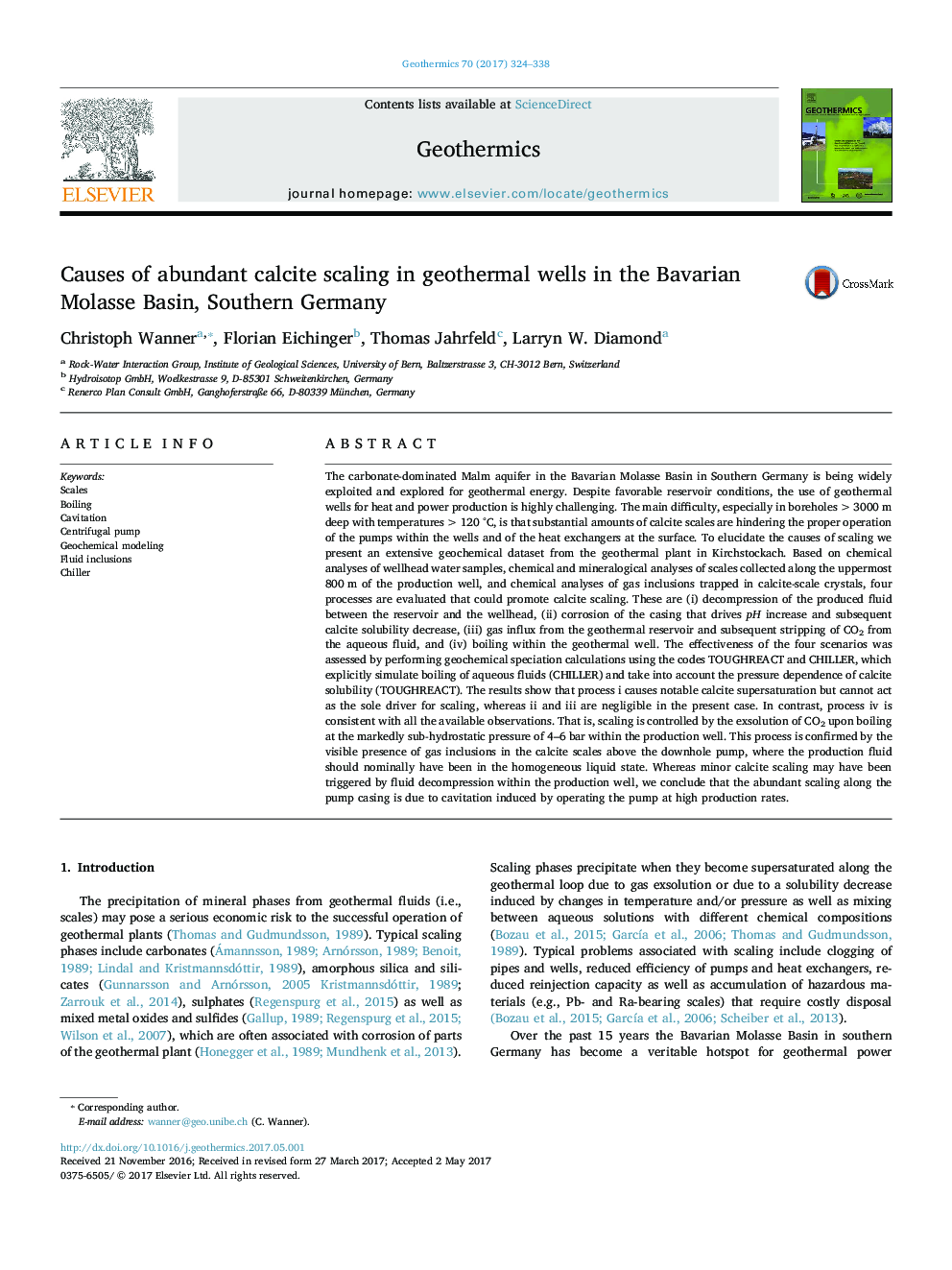| کد مقاله | کد نشریه | سال انتشار | مقاله انگلیسی | نسخه تمام متن |
|---|---|---|---|---|
| 5478655 | 1521899 | 2017 | 15 صفحه PDF | دانلود رایگان |
عنوان انگلیسی مقاله ISI
Causes of abundant calcite scaling in geothermal wells in the Bavarian Molasse Basin, Southern Germany
ترجمه فارسی عنوان
علل فراوانی پوسته شدن کلسیت در چاه های زمین گرمایی در حوضه باواریان مولاس، جنوب آلمان
دانلود مقاله + سفارش ترجمه
دانلود مقاله ISI انگلیسی
رایگان برای ایرانیان
کلمات کلیدی
مقیاسها، غلیان، کاویتاسیون، پمپ سانتریفیوژ، مدل سازی ژئوشیمیایی، واردات سیالات، چیلر
موضوعات مرتبط
مهندسی و علوم پایه
علوم زمین و سیارات
ژئوشیمی و پترولوژی
چکیده انگلیسی
The carbonate-dominated Malm aquifer in the Bavarian Molasse Basin in Southern Germany is being widely exploited and explored for geothermal energy. Despite favorable reservoir conditions, the use of geothermal wells for heat and power production is highly challenging. The main difficulty, especially in boreholes >3000 m deep with temperatures >120 °C, is that substantial amounts of calcite scales are hindering the proper operation of the pumps within the wells and of the heat exchangers at the surface. To elucidate the causes of scaling we present an extensive geochemical dataset from the geothermal plant in Kirchstockach. Based on chemical analyses of wellhead water samples, chemical and mineralogical analyses of scales collected along the uppermost 800 m of the production well, and chemical analyses of gas inclusions trapped in calcite-scale crystals, four processes are evaluated that could promote calcite scaling. These are (i) decompression of the produced fluid between the reservoir and the wellhead, (ii) corrosion of the casing that drives pH increase and subsequent calcite solubility decrease, (iii) gas influx from the geothermal reservoir and subsequent stripping of CO2 from the aqueous fluid, and (iv) boiling within the geothermal well. The effectiveness of the four scenarios was assessed by performing geochemical speciation calculations using the codes TOUGHREACT and CHILLER, which explicitly simulate boiling of aqueous fluids (CHILLER) and take into account the pressure dependence of calcite solubility (TOUGHREACT). The results show that process i causes notable calcite supersaturation but cannot act as the sole driver for scaling, whereas ii and iii are negligible in the present case. In contrast, process iv is consistent with all the available observations. That is, scaling is controlled by the exsolution of CO2 upon boiling at the markedly sub-hydrostatic pressure of 4-6 bar within the production well. This process is confirmed by the visible presence of gas inclusions in the calcite scales above the downhole pump, where the production fluid should nominally have been in the homogeneous liquid state. Whereas minor calcite scaling may have been triggered by fluid decompression within the production well, we conclude that the abundant scaling along the pump casing is due to cavitation induced by operating the pump at high production rates.
ناشر
Database: Elsevier - ScienceDirect (ساینس دایرکت)
Journal: Geothermics - Volume 70, November 2017, Pages 324-338
Journal: Geothermics - Volume 70, November 2017, Pages 324-338
نویسندگان
Christoph Wanner, Florian Eichinger, Thomas Jahrfeld, Larryn W. Diamond,
